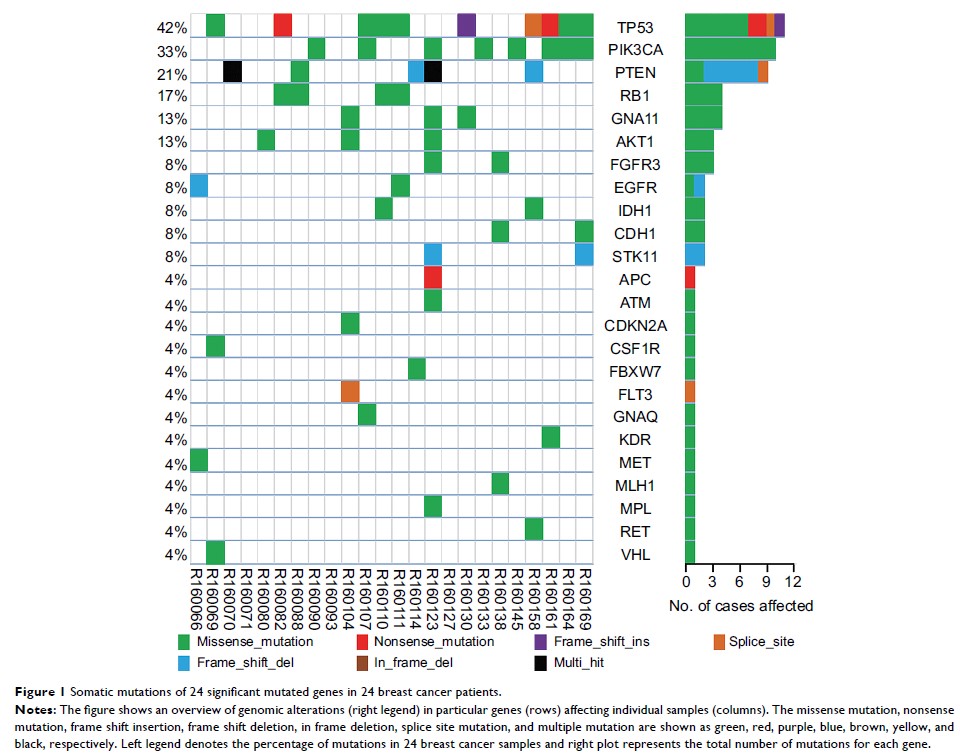108384
论文已发表
注册即可获取德孚的最新动态
IF 收录期刊
- 3.4 Breast Cancer (Dove Med Press)
- 3.2 Clin Epidemiol
- 2.6 Cancer Manag Res
- 2.9 Infect Drug Resist
- 3.7 Clin Interv Aging
- 5.1 Drug Des Dev Ther
- 3.1 Int J Chronic Obstr
- 6.6 Int J Nanomed
- 2.6 Int J Women's Health
- 2.9 Neuropsych Dis Treat
- 2.8 OncoTargets Ther
- 2.0 Patient Prefer Adher
- 2.2 Ther Clin Risk Manag
- 2.5 J Pain Res
- 3.0 Diabet Metab Synd Ob
- 3.2 Psychol Res Behav Ma
- 3.4 Nat Sci Sleep
- 1.8 Pharmgenomics Pers Med
- 2.0 Risk Manag Healthc Policy
- 4.1 J Inflamm Res
- 2.0 Int J Gen Med
- 3.4 J Hepatocell Carcinoma
- 3.0 J Asthma Allergy
- 2.2 Clin Cosmet Investig Dermatol
- 2.4 J Multidiscip Healthc

PIK3CA 突变在中国中部乳腺癌患者中的独特临床病理学和预后意义
Authors Wu H, Wang W, Du J, Li H, Wang H, Huang L, Xiang H, Xie J, Liu X, Li H, Lin W
Received 20 November 2018
Accepted for publication 15 January 2019
Published 14 February 2019 Volume 2019:11 Pages 1473—1492
DOI https://doi.org/10.2147/CMAR.S195351
Checked for plagiarism Yes
Review by Single-blind
Peer reviewers approved by Dr Amy Norman
Peer reviewer comments 2
Editor who approved publication: Dr Antonella D'Anneo
Purpose: The
mutation status and prognostic value of PIK3CA in breast cancer were widely investigated,
which showed significant difference among the patients from vast areas around
the world. In this study, the frequency, distribution, bias, and burden
of PIK3CA mutations
and their relationships with clinicopathologic variables and prognostic
significances were investigated in the breast cancer patients from Central
China.
Materials and methods: Somatic
mutations in exon 9 and exon 20 of PIK3CA gene were analyzed using Sanger sequencing
combining with targeted next generation sequencing in 494 breast cancer
patients from Central China. The correlations between PIK3CA mutations
and clinicopathological characteristics and the prognostic values of
multiple PIK3CA mutation
statuses were evaluated.
Results: PIK3CA mutations
were found in 38% of the patients and associated with estrogen
receptor-positive, progesterone receptor-positive, low Ki67 labeling index, and
luminal/human epidermal growth factor receptor 2-enriched subtypes. Meanwhile,
the prognosis of the total patients and the patients in old diagnostic age,
progesterone receptor-negative, low Ki67 labeling index, and luminal/human
epidermal growth factor receptor 2-enriched subgroups was significantly related
to PIK3CA mutations.
Most interestingly, the distribution, bias, and burden of PIK3CA mutations
were correlated with different clinical, pathological, and molecular features
as well as distinct prognostic implications in multiple breast cancer
subgroups.
Conclusion: The
frequency, distribution, bias, and burden of PIK3CA mutations
were associated with various clinical, pathological, and molecular
characteristics in the breast cancer patients from Central China. These different
mutation statuses can be used as potential indicators of prognosis in multiple
breast cancer subgroups.
Keywords: breast
cancer, PIK3CA ,
clinicopathological characteristics, prognosis
